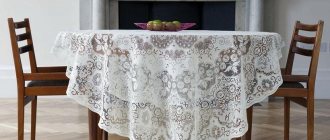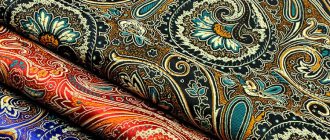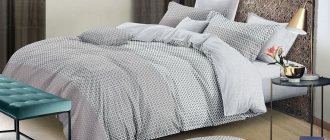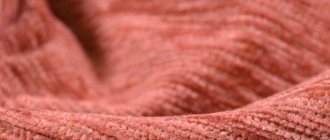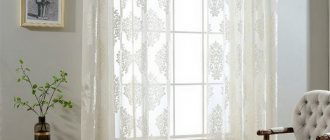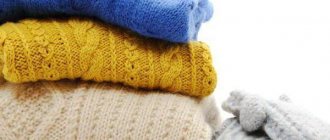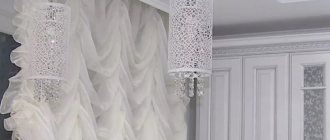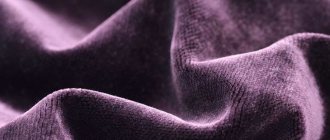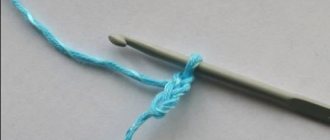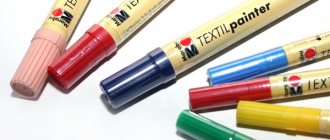Lace is an amazing creation of the world of textiles, performing one single task - to decorate: clothes, linen, interiors...
By sewing an openwork collar or cuffs to your favorite blouse, you can give it a new fashionable life . The lace trim of a formal dress will turn it into a festive outfit. Lace is an integral part of luxurious women's underwear. A cute scarf with airy patterns will emphasize femininity, and an exquisite shawl will add charm to your look.
For wedding and evening dresses, lace is a must-have. And it's not just dresses. Openwork gloves are a cute wedding accessory and a necessary part of the dress code at formal receptions. A lace cape can be draped over your shoulders on a cool evening.
Lace panels, curtains, tablecloths, and pillow covers were very popular in the twentieth century. Today you rarely see lace in interiors.
Lace inserts decorate bed linen, table napkins, lamps and even cup holders are decorated with lace.
The history of lace is as intricate as lace patterns.
INTERESTING!
Despite the fact that lace is often associated with France, Italy is considered its birthplace.
It all started in the 15th century with a simple “reticella” (mesh). Over time, the patterns became more complex. Simple geometric designs began to replace complex floral motifs and even ornamental compositions.
The art of lace making was raised to unprecedented heights by the craftswomen of Flanders .
But we must thank France for the incredible popularity that lace has received. Lace fabrics, despite their high cost, were purchased in incredible quantities. Openwork fabric decorated the clothes of not only women, but also men.
Application
Lace fabric has a variety of uses. The airy material is used to create outfits and dresses for special events - weddings, proms, evening outs. Openwork fabrics are successfully used by fashion designers for exclusive models.
Expert opinion
Alyona
Fabric expert and technologist Alena Khlebnikova is ready to answer your questions.
Write to us
Small lace items can decorate any outfit and are always in demand. This could be a scarf or scarf, stole, collars and cuffs.
The material is in demand for the manufacture of women's panties, underwear, negligees, stockings and tights. The openwork element often decorates a handbag, fan, brooch, hat, earrings, necklace and even shoes.
Home textiles were not left without attention. Decorative inserts or trim decorate bedding sets, towels, curtains, tablecloths, and bedspreads.
Capes, curtains and napkins are made completely openwork and decorate the interior.
Machine lace making
Almost all lace that is sold in stores is industrially made.
Lace weaving remained a handicraft for many years. A special machine appeared at the beginning of the 19th century in England. Its mechanisms repeated the movement of the lacemaker's hands. Later, John Livers combined the jacquard and lace looms, creating the famous Livers loom, which imitates hand-weaving threads.
INTERESTING
Livers' machines are still in operation. They produce famous French lace. They use natural (cotton, wool, silk) and synthetic materials.
The operation of livery machines is based on punched cards. The pattern is recorded with a special code. Thousands of punched cards are required to produce complex designs.
VENETIAN CRAFTSWORKERS
A simple peasant woman and a lady from society devoted every free minute to needlework. This type of creativity gave European women the first lessons of dignity, developing the talents of some and giving others the opportunity to experience beauty. Look how the artist A. Paoletti depicted Venetian lacemakers.
The Venetians, the darlings of fate, unerringly trusted the great engravers who printed albums for embroidery and lace, used as a basis parchment (splinter) with a pattern and dots applied to it for sticking pins (if the craftswoman preferred to work on bobbins), but this type of lace also seemed to the Venetians too simple. They achieved unimaginable perfection in complex needle lace. A parchment with a pattern was sewn to the canvas, a pattern was sewn directly on it, after which the threads between the parchment and the canvas were cut and the pattern hung in the air. It was called “a stitch in the air.”
Needle lace, 1620-1640, Italy
ALWAYS IN FASHION
Machine-made tulle appeared in the late 30s of the 19th century, and machine-made lace appeared only towards the end of the century. And although people, even judging by the names, had a vague idea of where these laces came from, there was not a woman in Europe who had not heard of them.
Over time, antique lace will become the subject of collecting and museum competition. Experts will appear with a magnifying glass in their hands, distinguishing genuine lace from late and numerous fakes. Then all this will cease to interest the public and there will be almost no experts left. But the hearths of lace making will not go out. The glorious Brussels school, the center of crafts in Bruges and, of course, on the island of Burano in Venice, on the island of Tenerife in Spain.
Lace dresses have always occupied a special place in women's wardrobes. Ornate patterns attract everyone's attention and create an aura of magic and sophistication. Fashion designers never ignore them and constantly use them in their collections.
A string of dresses sparkles and shimmers, tall, slender girls show models made by hand especially for the fashion show by the best couturiers of the world, and like news from ancient times - lace. Guipures, tulle lace, machine copies of museum designs...Outstanding fashion houses assert the glory of French, Russian and Italian applied art from collection to collection. Lace items will never go out of fashion, because they have no equal in femininity, seductiveness and charm. Cunning weaves will always fascinate our eyes and captivate our gaze. Just add a lace applique to the dress and it will sparkle in a new way.
Valentin Yudashkin
Valentino
Of course, we don't wear huge starched lace collars now, but many moments from the past are still present in our wardrobe. This could be lace gloves or even a lace dress, lace frills and small collars. For the most part, these are all machine products, unfortunately. Modern life is not very conducive to people spending a lot of time on manual labor. But lace, born in women's hands, will always be the personification of feat and devotion to the creation process, into which an incredible amount of imagination, hard work and soul is invested.
Do you like lace?
Share your thoughts with readers!
Tell your friends about the history of lace!
Subscribe to the news to find out even more interesting things!
Best regards, Irina Shirokova.
SUBSCRIBE TO THE NEWSLETTER AND BE THE FIRST TO KNOW THE NEWS!
Your email:
Confidentiality guaranteed
Loading…
Share on social media networks
I like
Find out even more interesting things:
History of clothing - bolero
There are items of clothing that have thoroughly entered our wardrobe and will undoubtedly remain in it for a long time. And there are those that are optional, but...
Nightgown in the life of a modern woman
Today it is difficult to imagine a woman who would have no idea what a nightgown is, or at least once in her life has not...
Choker as a fashion accessory
Every season, a woman's wardrobe is replenished with more and more new accessories, which were forgotten for a while, but now return again updated and desired. Choker,...
What is a stole?
With the onset of cold days, you want to find an additional source of heat. There are quite a few of them in our modern world. One of them is a chic women’s accessory –…
Italian fashion of the 80s of the last century
If England, in our minds, was always prim and rebellious, France romantic and sensual, then Italy, in contrast to them, was associated with lightness, light,...
Handmade lace
Lace of various densities, reliefs, structures
- Wicker
- Using bobbins
- Sewn
- Needle
- Hardanger
- Knitted
- Knitting needles
- Crochet
- Nodular
- Macrame
- Tatting
- With picture overlay
Crochet lace
Short hook
Can be knitted in different directions and in the round
- Regular (German)
- Sirloin
- Bruges
- Irish
- Guipure
- Reticella
- On the fork
- On paper, glass
Long hook
For single-sided knitting. Reminds me of a knitting needle.
- Tunisian
- Afghan
- Victorian
Compound
In general, threads for lace today can be anything. Previously, they were made only from natural raw materials, mainly cotton or silk, but wool or linen fibers could also be used. By the way, depending on the chosen material, as well as the characteristics of the design, patterned materials can be either practically weightless or quite dense.
Manufacturing techniques have evolved. Gradually, they learned to produce lace fabric from metallized threads, creating textiles of fantastic beauty. Well, with the development of the polymer industry, amazing materials began to be made from synthetics, thereby significantly increasing their service life. The undeniable advantage of polyester threads is their increased strength, as well as the ability to create any weave. The canvases are strong, beautiful and truly durable.
Now that you know how and what lace is made from, it’s time to move on to a detailed description of its varieties.
Classification by technique
Whooping cough
Traditional lace. The openwork fabric is created using bobbins - special spools on which the thread is wound.
Macrame
Handmade knotted lace. Created without the use of tools.
Hardanger
Counted openwork embroidery. The name comes from a Norwegian fjord.
Tatting
Shuttle woven knotted lace.
INTERESTING
In the East, tatting lace was called “mauk” - a shuttle used to weave fishing nets.
Needle
Created with needles and threads. A design is applied to the fabric, the outline is embroidered with thick thread, then filled with a pattern of various stitches.
Chantilly
A type of French bobbin lace. The first canvases were created from black silk threads - an openwork mesh with floral patterns.
Guipure lace
Coupling type of lace. Convex lace elements are connected by mesh ligaments.
on knitting needles
A type of openwork knitting. Finished products are knitted according to the patterns.
Crochet
A popular method of making lace. Various crochet hooks are used. It features a variety of patterns and techniques.
Preparation method
There are two main classifications of types of openwork - according to the technique of execution and the place of its origin. According to the first principle, lace is divided into manual and machine.
Textiles woven on a machine can have a straight cut (for subsequent joining with another fabric) or a wavy edge for the final design of the finished product. The machine program contains data about what pattern, structure, and density the material should have. Moreover, the devices are capable of weaving multi-colored laces and even with the addition of metal fibers, as well as gluing decorative elements.
A hand-made openwork can be simply a canvas that is later used to decorate products, or a finished item, for example, clothes, napkins or accessories. Handmade lace can have fabric as a base (sewing or embroidery) or have no base at all.
What can you sew from lace?
Where is lace most often used? In wedding and evening dresses. Dresses for charming brides, made of snow-white or milky lace, complemented with light organza, airy chiffon, shimmering satin, royal taffeta - the embodiment of the image of a fairy-tale princess.
Cord lace is an excellent basis for creating luxurious dresses. Exclusive fabrics embroidered with sequins, beads, and rhinestones are an ideal choice for special occasions.
Delicate Chantilly lace - for cute blouses and light dresses.
Advantages
All lace products look very delicate and elegant - this is their main advantage. However, there are a number of others:
- textured look, characterized by a huge variety of solutions;
- high breathability, the skin breathes well even in hot summers;
- drapes remarkably well (with the exception of very dense varieties);
- wide scope of application, from clothing decoration to applied arts;
- fabric or knitted openwork fabrics practically do not wrinkle;
- an endless variety of designs, structures, colors;
- beautiful lace made from natural raw materials does not cause any irritation.
Modern fashion suggests sewing raincoats, suits, and jackets from lace.
Coats, bags, and shoes are decorated with lace. Lace is used to create stylish accessories.
Lace fabrics with a stretch effect, similar to openwork knitwear, are recommended for sewing tight-fitting items and creating individual elements that require elasticity.
Let's complement a modern lace outfit with stylish accessories:
- Buttons
- fringed
- Eyelets
- Braid
- Ribbons
We turn sewing made on cambric, similar to lace, into light summer outfits.
Advantages and disadvantages
When purchasing an item with openwork elements, it is important to have an objective idea of its pros and cons.
| Advantages | Flaws |
| Aesthetic, original appearance | High price |
| Versatility | The need to follow a number of rules for the care and use of lace items |
| Nice texture | |
| Environmental friendliness | |
| Hypoallergenic | |
| Breathability |
How to properly care for lace products
Lace is a delicate fabric that requires special care.
IMPORTANT!
Follow the manufacturer's recommendations on the product label.
- It is not recommended to wash lace clothes. Use dry cleaning .
- Wash lace underwear by hand at a temperature not exceeding 30 degrees . The use of bleaches and aggressive detergents is prohibited.
- Do not twist. Wring out in a towel.
- Do not machine dry.
- Do not dry in radiator or open sun.
- Store lace items that you rarely use in a box, wrapped in parchment paper or on hangers in special cases.
Care
Lace fabric is very delicate and requires delicate handling. To maintain an elegant structure, it is important to follow the rules of care.
- Hand wash only.
- Use warm water no higher than +40°.
- The machine may only be turned on for dense products.
- You need to put them in the drum in a washing bag.
- Choose a gel detergent for thin fabrics.
- It is recommended to use laundry soap. It is enough to soap the products and hold them in the soap solution for 20-30 minutes. Rinse thoroughly.
- After lightly squeezing, leave to drain.
- To dry, place on a horizontal surface and straighten out carefully.
- Iron with a warm iron through gauze or cotton cloth.
- Movements should be light so as not to damage the openwork structure.
Textured lace or lace with voluminous patterns cannot be ironed, just like synthetic lace.
Selection of openwork curtains
Creating beautiful openwork curtains is done in different ways. In the first case, separate independent woven fragments are sewn onto the base of the entire product.
This method gives the finished canvas a unique appearance. In the second option, a completely lace product is created.
To make lambrequins, a paid fabric base is used or, as an alternative, a foam rubber base - a gang. Interiors with photos of openwork curtains, where a woven patterned ornament is combined with an almost transparent light fabric, look truly charming.
If you place openwork curtains in the bedroom, the entire space will be filled with even greater calm and intimacy. And by placing such textiles in the living room, you can achieve unprecedented solemnity from the interior.
The main feature of such window curtains is their ability to make the atmosphere in any room light, more comfortable and homely warm. Thanks to numerous master classes, today you can easily create openwork curtains with your own hands and decorate your home with them.
Furniture decoration
Furniture in lace is so beautiful and delicate. Therefore, many choose this particular method of decoration. To implement such an interior solution, they use the method of gluing ready-made lace. Typically, this applies to cabinet furniture. The algorithm for gluing lace on furniture is as follows:
- All fittings are removed;
- The lace material is cut according to the required size;
- The surface is coated with glue;
- The lace is applied and ironed with a dry brush from the center to the edges without pressure;
- Excess glue is wiped off with a dry cloth.
To realize your idea, you will need to purchase the material itself, PVA glue, scissors and brushes. A day after completion of work, the product is coated with acrylic varnish. Then all the fittings are returned to their place.
What kind of furniture is decorated with lace? Sofas, bedside tables, sideboards, cabinets and tables undergo this transformation most often.
Openwork canvases for different types of premises.
When choosing fabric for decorating windows in a particular room, you should take into account its features and purpose.
For the sleeping space, it is better to choose curtains made of linen or cotton. Curtains made of linen fabric allow air flow to pass through perfectly and do not accumulate dust on their surface. A floral design on a white background will bring an atmosphere of relaxation and tranquility to the room.
Bathroom curtains and screens
Ways to care for blinds- Attic curtains - 70 photos of modern options in the interior!
For the living room, synthetic curtains with tiebacks would be a good option. To create more subdued, dim lighting, you can complement the composition with thicker curtains. But the real decoration of the living room windows will be the openwork cord for curtains, which will make the whole composition complete and solemn.
You can also place openwork curtains in the kitchen. Since such curtains are subject to frequent washing, it is better to select fabrics with a synthetic base and use threads with high strength values.
Openwork curtains in the house will create a special atmosphere of comfort and warmth.
